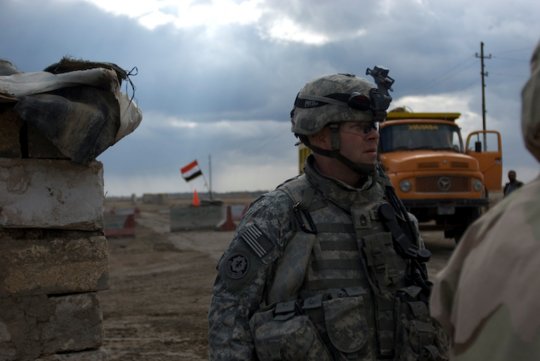
Sgt. 1st Class Shawn Connell, a native of Polson, Mont., inspects an Iraqi checkpoint while patrolling with his team in Baghdad, Feb. 14
Bloodhound 17 Nabs 16 Caches in 10 Weeks
By 2nd Stryker Cav. Regt. PAO, MND-B
BAGHDAD, Iraq
His call sign is Big Dawg 17, but you might as well call him “Bloodhound 17” after he and his 30-man platoon sniffed out a total of 16 buried ammunition and weapons caches over a 10-wek period.
Sgt. 1st Class Connell, 40, a native of Polson, Mont., has the reputation of being tough, but fair, on his men. He is on his fifth consecutive year as a platoon sergeant, and he runs his platoon one way – his.
Connell is currently assigned to 1st Platoon, Battery B, Fires Squadron, 2nd Stryker Cavalry Regiment, Multi-National Division – Baghdad. His current tour of duty in Iraq marks his second stint, and he barks out orders like a drill sergeant.
“Take Bravo 17 (an up-armored humvee) down to maintenance and get it fixed,” he bellowed, “It blew cherry juice all over Route Lincoln.”
For his Soldiers, his instructions are well understood as they hurry to follow his guidance.
“The man is determined, said Spc. Ronald Butler, who hails from Bennett, Iowa. “I’ll just leave it at that.”
At the beginning of December, his platoon took over an area northwest of Baghdad in what used to be an al-Qaida stronghold that historically was a prime spot for hidden munitions and homemade explosives.
After a few days of searching, his platoon observed suspicious holes near an abandoned building. Four days later, the Soldiers seized munitions from two finds. In the first seizure, the captured a 2.75-inch rocket with 450 AK-47 rounds and 150 heavy machine gun rounds. At the second site, they nabbed four tank rounds.
By the time Christmas rolled around, approximately two months later, the platoon had sniffed out a total of 16 caches, including one on Christmas Day.
“I had to shell out $150 dollars to buy the platoon pizza,” said Connell reflecting on his platoon’s expensive find. “I promised them (his platoon) if they found a cache on Christmas, they’d get pizza from me.”
Maj. Tim Hunt asked Connell who it was that he and his platoon were so successful in finding the illegal munitions and weapons, to which Connell replied in his typical bluntness: “Sir, we just kick a lot of dirt.”
Hunt is from Dupont, Wash., and serves as the squadron’s executive officer.
Connell enlisted with the National Guard in January 1987 and is an artilleryman by trade. Four years later, he joined the active-duty ranks. He said he has spent the majority of his 21 years career behind the breech of a cannon, launching 100-pound projectiles into impact areas many miles away from his position.
The war in Iraq changed all of that for him – and many others. His first deployment was in northern Iraq, he said, and most of his time was spent raiding houses and looking for suspected terrorists – a duty formerly thought of as a job specifically for an infantryman. It was valued experience he carried through with him for his current tour.
“I’m amazed at how knowledgeable he is of the area,” said Spc. Matthew Pawlikowski, a native of Garfield, N.J., who serves as the platoon’s armorer.
The platoon’s largest cache to date was found in early February, the day after a car bomb exploded under a local sheik. His platoon took immediate action after receiving a tip. After two hours of searching, Connell was the one who found six 120mm mortar rounds and a complete 120mm mortar system buried underneath a staircase.
Another hour of searching yielded the discovery of a buried water tank filled with more than 4,000 pounds of munitions that included rocket-propelled grenades, grenades, detonation cord and mortars. An explosive ordnance disposal team was called in to destroy the seized cache.
As to what his plans are for when the deployment is over, he said “I’ll spend time with my newborn son.”
He also said he hopes to get an assignment with the University of Montana, where he would relish the opportunity to serve as an assistant instructor for the Reserve Officer’s Training Corps program so he can pass his knowledge to the Army’s next batch of fresh, young second lieutenants and, of course, to teach them “to kick a lot of dirt.”
